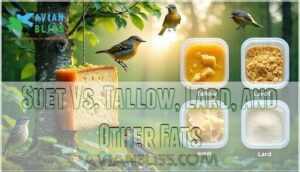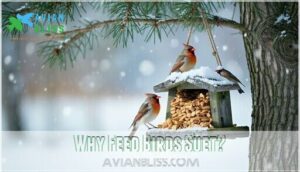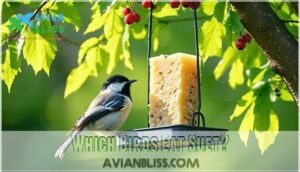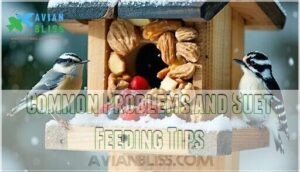This site is supported by our readers. We may earn a commission, at no cost to you, if you purchase through links.
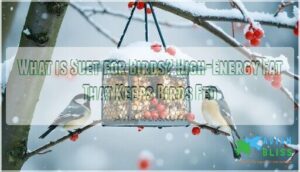
This dense fat provides up to 900 calories per 100 grams—nearly double what most seeds offer.
You’ll find suet has a melting point between 113°F to 122°F, making it stable in varying temperatures while remaining easy for birds to digest.
Its crumbly texture allows birds to break it apart effortlessly.
During winter months, suet becomes essential fuel for birds when natural food sources disappear.
The rendering process removes impurities while preserving nutritional value, creating clean energy that supports rapid metabolism and feather health.
Understanding proper storage and feeding techniques can transform your backyard into a winter sanctuary.
Table Of Contents
- Key Takeaways
- What is Suet for Birds?
- How is Suet Made and Processed?
- Suet Vs. Tallow, Lard, and Other Fats
- Why Feed Birds Suet?
- Which Birds Eat Suet?
- What Are Suet Cakes and Plugs?
- How to Make Suet for Birds at Home
- Where and How to Hang Suet Feeders
- Storing and Handling Suet Safely
- Common Problems and Suet Feeding Tips
- Frequently Asked Questions (FAQs)
- What you should know about feeding suet?
- What’s that Bird at your suet feeder?
- Do owls eat suet?
- When should you put out suet for birds?
- Is suet better than bird seed?
- What is bird suet made of?
- Where is the best place to put suet for birds?
- How do I make suet at home?
- What ingredients are best for attracting blue jays?
- How often should I be feeding birds suet?
- Conclusion
Key Takeaways
- You’ll provide concentrated energy when birds need it most – Suet delivers up to 900 calories per 100 grams, nearly double what seeds offer, making it an essential winter fuel when natural food sources disappear.
- You’ll attract specific bird species with high-fat nutrition – Woodpeckers, nuthatches, and chickadees rely on suet’s dense fats to fuel their active lifestyles and maintain body heat during cold weather.
- You can make your own suet or buy commercial versions – Render beef kidney fat at home and mix it with seeds, nuts, and fruits, or purchase ready-made suet cakes that combine convenience with consistent nutrition.
- You’ll need proper storage and placement for safety – Keep suet refrigerated or frozen to prevent spoilage, place feeders 5-6 feet high away from windows, and clean them regularly to avoid bacterial growth and disease transmission.
What is Suet for Birds?
Suet is the hard, white fat surrounding cattle and sheep kidneys that provides birds with essential high-energy calories.
You’ll find this nutrient-dense fat becomes a vital food source, especially during cold months when birds need extra energy to maintain their body temperature, with essential high-energy calories being crucial for their survival, and nutrient-dense fat playing a key role.
Definition of Suet
Understanding suet starts with knowing its Animal Source and unique Fat Properties.
This hard, crumbly fat comes from around cattle and sheep kidneys, creating the perfect high-energy fuel for your backyard visitors.
Pure kidney fat delivers the concentrated calories birds crave most
The Suet Composition contains high levels of stearin, giving it exceptional stability and a melting point between 113°F to 122°F.
Here’s what makes suet special for wild birds:
- White, crumbly Suet Texture that birds can easily break apart
- High smoke point (400°F) guarantees stability in varying temperatures
- Saturated fat content provides maximum energy density
- Natural preservation qualities keep bird suet feed fresh longer
- Clean Rendering Process removes impurities while maintaining nutritional value
This suet for backyard birds offers concentrated calories that fuel their high metabolisms, especially during cold months when natural food sources become scarce.
Why Birds Need Suet
Birds require suet as a high-energy fuel source that packs essential fats and calories into their small bodies.
This concentrated energy source becomes essential during winter survival when natural insects and seeds become scarce. Suet provides the calorie boost birds need to maintain body heat and support feather health through cold months.
Unlike other foods, suet delivers sustained energy that helps backyard birds power through harsh weather conditions. The rich fat content in suet for wild birds supports their rapid metabolism and energy demands.
Bird suet nutrition offers benefits that lighter foods simply can’t match, making high energy suet an important supplement for bird feeding enthusiasts.
How is Suet Made and Processed?
Understanding how suet is made helps you choose the best options for your backyard birds.
Commercial suet starts with raw beef or lamb fat from around the kidneys, which gets rendered through heating and purified to remove impurities.
This process is then followed by mixing the purified fat with bird-friendly ingredients.
Source of Suet (Beef, Lamb)
The backbone of quality suet comes from specific cuts of animal fat that pack the energy birds crave.
You’ll find the best suet sourced from three prime locations on cattle and sheep:
- Kidney fat – The hardest, purest fat surrounding the organs
- Loin fat – Dense tissue from the back area near the spine
- Heart fat – Rich deposits around the cardiac region
Beef suet dominates the bird feeding market because it’s readily available from meat processing facilities.
Lamb fat works equally well but costs more due to limited supply.
These meat byproducts transform into premium suet for wild birds through careful selection – only clean, white fat makes the cut.
Processing plants remove blood vessels, connective tissue, and skin before the fat sources move to rendering facilities.
This high energy suet becomes the foundation for nutritious bird suet nutrition that keeps backyard visitors coming back.
The use of high energy suet is essential for attracting various bird species to your garden.
Rendering and Purification Process
Raw suet’s transformation into safe bird food begins with the rendering process.
Fat rendering involves heating raw suet slowly in a pot or slow cooker, keeping temperatures low to prevent burning while separating pure fat from tissue.
The filtering process requires straining melted fat through cheesecloth twice, removing impurities for proper suet purification.
During cooling techniques, the liquid hardens into stable cakes with ideal melting points for bird suet nutrition.
This rendering process creates high energy suet that resists spoilage, making suet for wild birds safer than raw alternatives.
Different suet types emerge based on processing methods and added ingredients, resulting in a high energy suet that is beneficial for bird nutrition, with a focus on proper suet purification and stable cakes.
Suet Vs. Tallow, Lard, and Other Fats
You’ll encounter several animal fats when feeding birds, but suet stands out with unique properties that make it superior for avian nutrition.
While tallow is rendered suet, lard comes from pork, and other fats lack suet’s high melting point and energy density that birds need.
Key Differences and Similarities
When choosing between different fats for your backyard bird feeding strategies, you’ll notice distinct differences that affect bird preferences.
Suet contains up to 60% saturated fat compared to lard’s 40%, making it denser in calories. The rendering process transforms raw suet into stable tallow, while lard stays softer at room temperature.
| Fat Type | Melting Point | Stability |
|---|---|---|
| Suet/Tallow | 113-122°F | High |
| Lard | 86-104°F | Medium |
| Shortening | 75-85°F | Low |
All animal fats attract woodpeckers and nuthatches to bird suet feeders, but suet’s firmness makes better suet cake recipes.
Winter bird suet works best because higher melting points resist spoilage when temperatures fluctuate, unlike softer alternatives that melt quickly in suet bird feed applications.
Unique Properties of Suet
When examining suet’s characteristics, you’ll discover it outperforms other fats in several ways.
Its firm texture holds shape better than lard, creating stable suet cakes that won’t crumble.
The high melting point (113-122°F) and elevated smoke point make suet ideal for year-round feeding without messy dripping.
| Property | Suet | Lard | Vegetable Fat |
|---|---|---|---|
| Melting Point | 113-122°F | 86-104°F | 95-115°F |
| Fat Composition | 60% saturated | 40% saturated | Variable |
| Energy Density | 900 cal/100g | 850 cal/100g | 700-800 cal/100g |
| Suet Texture | Firm, crumbly | Soft, creamy | Semi-solid |
These bird suet benefits attract suet for woodpeckers, suet for robins, and suet for bluebirds effectively.
Quality suet bird feed maintains nutritional value longer than alternatives.
Why Feed Birds Suet?
You’ll want to provide suet because it delivers concentrated calories and essential fats that help birds maintain energy reserves during demanding seasons.
Winter feeding becomes especially critical when natural food sources disappear and birds need extra fuel to survive freezing temperatures, and it is crucial for them to have essential fats.
Nutritional Benefits for Birds
Bird suet delivers powerful nutrition that supports avian health year-round.
This high-fat food source provides concentrated energy essential for flight, territory defense, and daily survival activities.
Key bird suet benefits include:
- Energy Boost – Nine calories per gram fuel high metabolic rates
- Feather Health – Protein content maintains plumage integrity during molt
- Winter Survival – Fat reserves help birds withstand cold temperatures
Suet for woodpeckers, cardinals, and bluebirds supports muscle development and tissue repair.
The easily digestible fat converts rapidly to usable energy, reducing foraging time.
Enhanced calorie intake from suet helps birds build necessary fat stores for overnight fasting and migration flights, while supporting thermoregulation during harsh weather conditions.
To maximize the benefits of suet, this is necessary to use suet feeding methods that cater to different bird species and their unique needs.
Seasonal Importance (Winter Feeding)
Winter transforms from a season of abundance to survival mode for our feathered friends.
As temperatures drop and natural food sources become scarce, birds require substantially more calories to maintain their body heat and energy levels.
Your suet feeder becomes a lifeline during these harsh months, providing concentrated fats that deliver twice the energy of carbohydrates or proteins.
Cold weather feeding strategies should focus on high-fat options like suet for cardinals and finches, who desperately need these calories before bird migration or to survive freezing nights.
Smart suet feeder plans position feeders where birds can quickly access winter nutrition while staying protected from wind and predators.
Which Birds Eat Suet?
You’ll attract an impressive variety of birds to your suet feeders, from acrobatic woodpeckers to tiny nuthatches.
Insect-eating species like chickadees, wrens, and flickers rely on suet’s high-fat content to fuel their active lifestyles year-round, which includes species like chickadees.
Common Suet-Eating Birds
Woodpeckers dominate suet feeders, with Downy, Hairy, Red-bellied, and Pileated Woodpeckers visiting regularly.
Their feeding habits make them natural suet consumers, while Northern Flickers and Yellow-bellied Sapsuckers join during colder months.
Chickadees, nuthatches, and titmice also rely heavily on suet’s high-energy content for avian nutrition.
Black-capped and Carolina Chickadees pair with White-breasted Nuthatches at feeders, creating lively feeding scenes.
Blue Jays cache suet pieces, demonstrating different suet preferences among bird species.
Even smaller birds like Bewick’s Wrens supplement their diet with suet when insects become scarce, proving this woodpecker diet staple appeals to diverse species.
Species Attracted by Suet
Beyond the usual suspects, you’ll find surprising visitors at your suet feeders.
Yellow-rumped warblers stop by during bird migration, while cardinals and finches occasionally sample suet mixed with seeds.
Feeder designs matter – upside-down models favor woodpeckers over starlings.
Regional species like California towhees and shrikes also discover suet’s benefits.
Even mockingbirds and tanagers visit fruit-based suet cakes.
Your woodpecker diet staples attract diverse species seeking avian nutrition, especially when natural food sources dwindle.
Smart bird feeding suet placement and varied suet preferences create feeding opportunities for unexpected guests beyond traditional suet-eating birds.
During winter, suet provides critical nutrition when natural food is scarce, offering a vital source of avian nutrition.
What Are Suet Cakes and Plugs?
When you provide suet to birds, you’re typically offering processed suet cakes or plugs rather than raw fat.
These convenient forms combine rendered suet with nutritious ingredients like seeds, nuts, dried fruits, and sometimes mealworms to create energy-dense feeding blocks that birds can easily consume.
Ingredients Mixed With Suet
When creating bird feeding suet, you’ll mix various ingredients with rendered fat to boost nutritional value and attract different species.
Popular seed varieties include sunflower hearts, millet, and nyjer that appeal to cardinals and finches. Nut choices like chopped peanuts, tree nuts, or peanut butter suet create protein-rich blends.
Fruit additions such as dried cranberries, raisins, or chopped apples add natural sugars birds crave. Some recipes include insect inclusion like mealworms for woodpeckers and nuthatches.
Binding agents like flour or cornmeal help hold your homemade suet mix together, creating firm cakes that won’t crumble in feeders. Consider seasonal timing for ideal bird attraction.
Commercial Vs. Homemade Suet Cakes
When choosing between commercial and homemade suet cakes, you’ll find distinct advantages to each approach.
Store-bought options offer convenience and consistent nutritional value, while homemade suet mix gives you complete control over ingredient quality and cost comparison.
Key considerations for your decision:
- Additive concerns – Commercial products may contain preservatives you’d rather avoid
- Bird preference – Different species like suet for cardinals versus suet for finches have varying needs
- Customization – Homemade allows specific bird seed combinations and suet alternatives
- Freshness – You control preparation timing and storage conditions
Homemade versions typically cost less and let you avoid questionable additives, but commercial cakes provide tested formulations that attract diverse bird species consistently.
You can find resources for purchasing suet ingredients online.
How to Make Suet for Birds at Home
You can easily create nutritious suet for backyard birds using basic kitchen ingredients and simple techniques.
This homemade approach lets you control the quality and customize ingredients to attract specific bird species in your area, using basic kitchen ingredients.
Basic Homemade Suet Recipe
Making your own suet starts with one pound of beef or lamb fat, cut into small cubes for even melting. Heat the fat slowly over low flame for 30-60 minutes until fully liquefied—don’t rush this process or you’ll burn your ingredient ratios.
Strain the liquid through cheesecloth to remove gristle, creating smooth texture variations that birds prefer. Pour into molds and refrigerate until white and firm.
This basic recipe serves as your foundation for recipe customization, whether you’re targeting suet for cardinals or suet for finches. Proper mold prevention comes from clean utensils and fresh fat.
You can also find suet making supplies online. Store finished cakes in airtight containers as effective suet alternatives to store-bought options, following these suet feeding tips for best results.
Adding Seeds, Nuts, and Fruits
Once you’ve mastered the basic recipe, enhancing your food grade suet with natural ingredients transforms it into a bird buffet.
Seed types like black oil sunflower seeds and nyjer attract different species, while nut selection matters—unsalted peanuts and tree nuts provide protein punch.
Fruit choices include dried cranberries, raisins, and chopped apples that won’t spoil quickly.
Ingredient ratios typically follow a 2:1 suet-to-additions rule, though bird preferences vary by region.
Woodpeckers favor nuts, while finches prefer smaller seeds.
These suet feeding tips help maximize your bird watching success.
Animal fats hold everything together, creating nutritious cakes that satisfy diverse appetites throughout winter months.
Where and How to Hang Suet Feeders
Proper feeder selection and strategic placement maximize bird attraction while ensuring their safety and health.
You’ll want to choose feeders designed for upside-down feeding and position them away from windows and predator hiding spots.
Choosing The Right Feeder
Your suet feeder choice directly impacts which birds you’ll attract and how well they can access the animal fat. Cage-style feeders work best for most backyard bird watching, offering excellent weather protection while preventing larger animals from stealing suet cakes.
Wire mesh feeders allow multiple birds to feed simultaneously, though they provide less food storage protection. Consider feeder material carefully – metal construction withstands weather better than plastic alternatives.
Look for mounting styles that suit your space: pole-mounted feeders offer flexibility, while hanging options work well under eaves. Feeder capacity matters too; larger models reduce refilling frequency but may encourage animal fat usage by unwanted visitors.
Upside down feeders deter starlings effectively. Baffle options become essential for deterring squirrels and raccoons who consider animal fats irresistible treats, and proper mounting styles can enhance the overall feeding experience by providing excellent weather protection.
Placement Tips for Bird Safety
Strategic placement transforms your backyard into a safe haven for feeder birds. Position suet feeders 5-6 feet high for ideal Feeder Height, deterring ground predators while remaining accessible.
Maintain 10-15 feet from dense cover—close enough for escape routes but preventing Predator Avoidance issues. Choose shaded spots for Weather Protection, keeping this animal fat from melting or spoiling.
Guarantee clear Visibility Concerns by avoiding cluttered areas where birds can’t spot approaching threats. Select Safe Materials like powder-coated metal feeders that won’t rust or harbor bacteria.
Consider optimal mounting solutions for stability. Remember, these food ingredients and animal products require the same care as traditional recipes—proper placement keeps your cooking tips for birds both safe and effective.
Storing and Handling Suet Safely
Proper suet storage prevents bacterial growth and keeps your feathered visitors healthy and well-fed.
You’ll need to refrigerate fresh suet within five days or freeze it for up to six months to maintain quality and safety.
Refrigeration and Freezing Tips
Proper refrigeration keeps your suet fresh and safe for feathered visitors.
Store commercial suet cakes in the fridge for several weeks once opened, while homemade versions stay good for 1-2 weeks in airtight containers.
For bulk storage, freezing extends shelf life up to a year—freeze individual portions for easy thawing.
Only thaw what you’ll use immediately to prevent bacterial growth.
Cold suet holds its shape better when placing in feeders, and chilled animal fat won’t melt as quickly outdoors.
Check for freshness indicators like off-smells or discoloration before serving.
To maintain quality, consider airtight food containers to prevent spoilage.
These food storage practices guarantee your cooking tips and baking uses knowledge translates to safe bird feeding.
Preventing Spoilage and Disease
When handling animal fat for bird feeding, bacteria multiply rapidly in warm conditions, making Safe Handling practices essential for preventing Bacterial Growth and Aflatoxins Risk.
Poor food storage can turn your well-intentioned bird feeding into a health hazard through contaminated nutrition science.
Follow these Feeder Hygiene and Mold Prevention steps:
- Clean feeders weekly with 10% bleach solution to eliminate harmful bacteria
- Remove old suet within 2-3 days during warm weather to prevent spoilage
- Store unused suet in sealed containers in refrigerator or freezer
- Inspect regularly for green mold, rancid odors, or slimy textures
- Replace immediately if you notice any signs of contamination or spoilage
Proper food preparation protects both birds and your family from foodborne illness while maximizing the health benefits of this high-energy nutrition.
Common Problems and Suet Feeding Tips
Even experienced bird feeders face challenges when offering suet, especially during temperature extremes and unwanted visitors.
Understanding how to manage suet in warm weather and deter pests will help you maintain a successful feeding station year-round, by knowing how to manage suet effectively.
Suet in Warm Weather
Hot weather poses three significant challenges for suet feeders. High temperatures can cause this saturated fat to melt and spoil, creating rancidity risks that harm bird health. Melting prevention becomes essential when temperatures exceed 70°F.
| Temperature Range | Recommended Action |
|---|---|
| Below 70°F | Regular suet works fine |
| 70-85°F | Switch to no-melt suet recipes |
| Above 85°F | Remove feeders temporarily |
Alternative feeders with better ventilation help reduce heat buildup. Summer recipes using less animal fat cooking ingredients prevent melting issues. However, warm suet attracts insects and can spoil quickly, requiring frequent food storage monitoring and replacement to maintain bird safety.
Keeping Pests and Critters Away
Squirrel baffles and cage feeders offer your best defense against clever raiders.
Position feeders at least ten feet from launch points—squirrels can leap eight feet horizontally with surprising accuracy.
Barrel-shaped baffles placed four to five feet above ground create effective barriers when properly maintained.
Double-cage designs allow small birds through outer mesh while blocking starlings and persistent mammals.
Hot pepper-infused suet cakes deter most pests without affecting birds, though some debate exists about safety.
Regular cleaning prevents rodent attraction beneath feeders.
Unlike storing this animal fat cooking ingredient indoors, outdoor feeders require different food storage approaches.
Upside-down feeders favor woodpeckers while frustrating larger nuisance species through smart predator awareness strategies.
Frequently Asked Questions (FAQs)
What you should know about feeding suet?
You’ll attract woodpeckers, nuthatches, and chickadees by offering suet during fall and winter when birds need extra calories.
Clean feeders regularly, remove spoiled suet, and use upside-down feeders to favor target species while reducing disease transmission risks.
What’s that Bird at your suet feeder?
Yesterday, Sarah spotted a red-headed woodpecker clinging to her backyard suet feeder.
You’re likely seeing woodpeckers, nuthatches, chickadees, or wrens—all insect-eating species that crave suet’s high-fat content for energy, especially during colder months.
Do owls eat suet?
Owls don’t typically eat suet at feeders.
They’re nocturnal raptors that hunt live prey like rodents, small birds, and insects.
You won’t see them hanging upside down at your suet feeder.
When should you put out suet for birds?
Fall and winter months bring ideal timing for suet feeding.
Birds need extra calories during cold weather to maintain body heat.
You’ll provide essential energy when insects become scarce and natural food sources dwindle substantially, which is crucial for the birds’ survival during these months with scarce resources.
Is suet better than bird seed?
Suet isn’t necessarily better than bird seed—they’re complementary. You’ll find suet provides high-energy fats that attract insect-eating birds like woodpeckers and nuthatches, while seeds appeal to different species entirely.
What is bird suet made of?
In the bird’s-eye view of things, you’ll find bird suet made from rendered animal fat (usually beef kidney fat) mixed with seeds, nuts, dried fruits, and sometimes mealworms or other protein-rich ingredients.
This is for ideal nutrition.
Where is the best place to put suet for birds?
Place your suet feeder 5-6 feet high on a sturdy pole or tree trunk, away from windows but visible from indoors.
Choose a quiet spot that’s easily accessible for refilling and cleaning, ensuring it’s a quiet spot.
How do I make suet at home?
Though homemade suet seems complex, you’ll find it surprisingly straightforward.
Melt beef fat slowly, strain out impurities, then mix with birdseed while cooling.
The rendered fat solidifies into nutritious cakes perfect for attracting woodpeckers and chickadees to your yard.
What ingredients are best for attracting blue jays?
You’ll attract blue jays with peanuts, sunflower seeds, corn, and cracked nuts mixed into your suet.
They’re also drawn to dried fruits like raisins, making these protein-rich combinations irresistible to these intelligent corvids.
How often should I be feeding birds suet?
Wondering how to keep your feathered friends well-fed?
You should offer suet consistently during fall and winter when birds need extra calories for warmth.
Refilling feeders every few days as needed.
Conclusion
Like Prometheus bringing fire to mortals, you’re now equipped to provide life-sustaining energy to your feathered visitors.
Understanding what’s suet for birds transforms winter feeding from guesswork into precision nutrition.
You’ll offer 900-calorie fuel that supports essential metabolic functions when natural resources vanish.
Through proper storage, strategic placement, and quality ingredients, you’ve created a reliable energy source.
Your backyard becomes a vital refueling station where birds can thrive despite harsh conditions, providing them with essential metabolic functions.
- https://www.perkypet.com/articles/the-benefits-of-feeding-suet-to-birds
- https://www.birdsandblooms.com/birding/attracting-birds/feeding-birds/common-questions-suet/
- https://en.wikipedia.org/wiki/Suet
- https://underatinroof.com/blog/how-to-make-homemade-suet-for-birds
- https://www.thelookoutaz.com/weekly-articles/read-bird-suet-labels-to-ensure-nutritional-value


